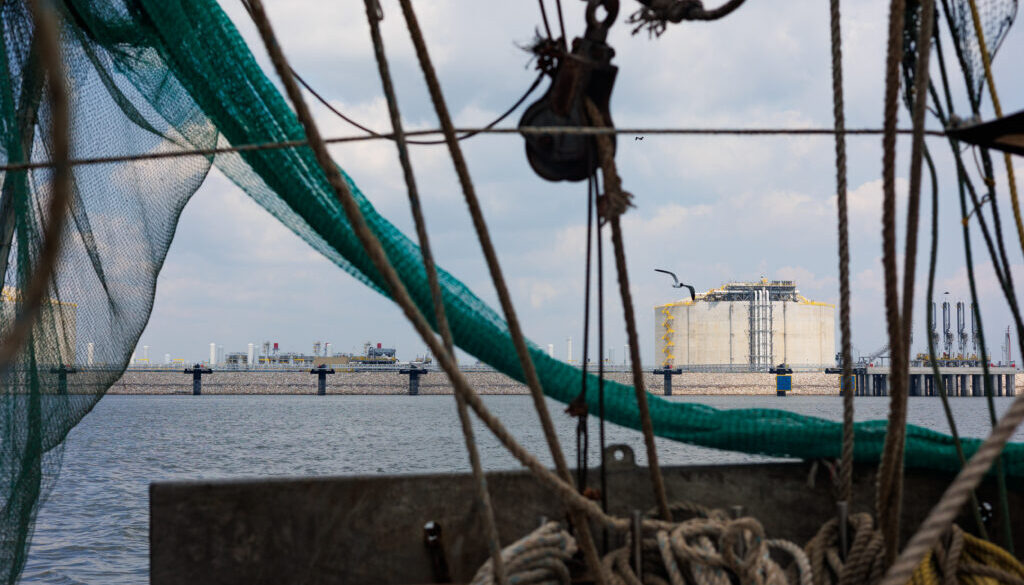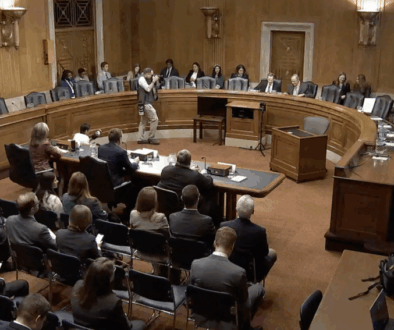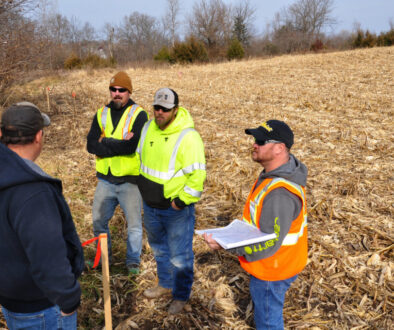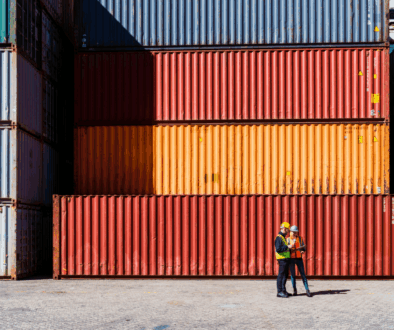Booming natural gas exports threatening Gulf Coast fishing communities
Most mornings, Nathan Berwick rises well before dawn at his home in Calcasieu Parish, Louisiana, setting out on nearby Lake Charles in a small fishing boat to check his crab traps. If it’s not too hot and the water is calm, Berwick’s family occasionally joins him on the boat. His eleven-year-old daughter enjoys playing with baby crabs that fall from the traps as Berwick hauls them from the water.
Berwick comes from a long line of crabbers dating back to the 1820s, when his ancestors first arrived in the heel of the Louisiana boot – the state’s southwest corner.
“Thirty years from now I want my children to be able to say, ‘this is my home, this is where eight generations of Berwicks have lived,’” he said.
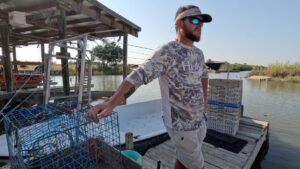
But this simple dream is in danger from a growing threat facing Berwick and others who contribute to – and depend on – the $1.5 billion fishing industry along Louisiana’s Gulf Coast.
The fossil fuel industry has identified the Gulf region as a key site for expanding liquified natural gas (LNG) export terminals. Eight new terminals are planned for southwest Louisiana alone, with a total of at least 16 new LNG projects anticipated for the Gulf region in coming years.
The terminals take in gas from transmission pipelines, cool it to a liquid, and store it for overseas exports. LNG is considered the cleanest of fossil fuels because it produces less carbon dioxide than coal and oil. And industry groups, including the Center for LNG, claim the fuel is vital to a clean energy future, with the potential to provide energy security and “lift people out of poverty.”
But environmental groups and concerned residents call the claims “greenwashing,” citing emissions of the potent greenhouse gas methane and other air pollutants associated with LNG facilities, leakage, and emissions along its supply chain. They also point to a history of alleged shoddy operating practices that jeopardize public health and safety – all forced on communities with little consent.
And for Louisiana’s Gulf Coast in particular, critics say the rise of the LNG industry is threatening to wipe out a way of life that has endured for generations, and exacerbate the suffering of Gulf communities already plagued by climate-driven disasters.
“The gas export industry is going to be the nail in the coffin for the fishermen and their ability to survive,” said Anne Rolfes, director of the grassroots group Louisiana Bucket Brigade, which works with towns and neighborhoods impacted by pollution from oil and gas infrastructure.
An LNG export boom
Most existing LNG and planned terminals are situated along the Gulf Coast, perhaps in part due to the region’s oil- and gas-friendly regulatory environment. The US recently became the world’s largest LNG exporter following an increase in global prices for methane gas after Russia’s invasion of Ukraine, which led to 45 long-term contracts to export US-produced methane overseas, according to a 2023 report by environmental and consumer advocacy nonprofits.
But while the industry claims US LNG exports will help support national security in Europe, the report finds that more than three-fourths of the LNG stipulated in the new contracts will be shipped to Asia or commodity traders.
The Biden administration has largely supported US LNG exports, which generated $35 billion in revenue through September in 2022 – more than four times the revenue generated in the same period in 2021.
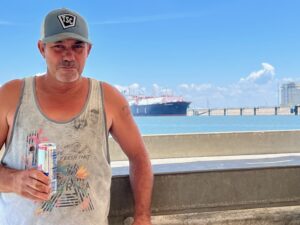
US enthusiasm for LNG exports comes as the world waffles on what its relationship with oil and gas should look like as climate change continues to escalate. On September 9, global leaders at the G20 summit in India, whose members include the US, vowed to triple renewable energy but failed to reach a deal to phase out fossil fuels. If the LNG export industry continues to expand as expected, it could become nearly impossible to keep global temperatures from increasing less than 1.5 degrees Celsius, which scientists have identified as a threshold for the worst impacts of climate change, according to a December 2020 report by the Natural Resources Defense Council (NRDC).
The US currently has five LNG terminals operating on the Gulf Coast, in Louisiana and Texas. Two of the Louisiana terminals are located adjacent to communities at opposite ends of Calcasieu Lake – Venture Global’s Calcasieu Pass, which started sending out export cargoes in 2022, and Sempra Energy’s Cameron LNG, which started full commercial operations in 2020. Another facility, Sabine Pass LNG, sits about an hour to the west on the Louisiana-Texas border.
Environmental groups have been opposing a federal permit for a new $25 billion export facility planned for Calcasieu Parish, Driftwood LNG, arguing that the permit failed to account for how the project’s potential to damage wetlands. Earlier this month, the US Fifth Circuit Court of Appeals in New Orleans rejected their challenge.
Flaring and fire hazards
Louisiana’s LNG export terminals have triggered numerous health and safety concerns. The Cameron LNG facility has accidentally released harmful gases 67 times since its export operations began in 2020, according to a 2022 report by the Louisiana Bucket Brigade. Almost three-quarters of these incidents have resulted from repeated failures by the same piece of equipment, the thermal oxidizers. Whenever they shut off, the plant releases methane, volatile organic compounds (VOCs), and cancer-causing benzene into the air.
While the Environmental Protection Agency (EPA) has found that Cameron LNG has underreported the emissions from these incidents, the report says that the company has not been penalized. Furthermore, although the Calcasieu Pass facility has been in operation for less than two years, its tenure has been “rife with flaring and accidents,” according to the Bucket Brigade report.
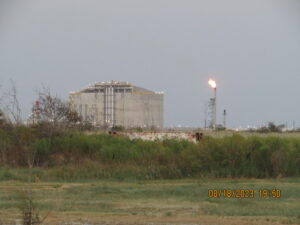
Flaring, when a terminal releases and burns gases, is considered a mechanism for safety and pollution control. But if the hydrocarbons it releases aren’t completely burned, they can contribute to air pollution and pose a huge safety hazard, said John Allaire, a retired engineer and environmental consultant who lives in Cameron Parish, a little over a mile from the Calcasieu Pass terminal.
“I see how they operate every day,” said Allaire, who has been documenting the Calcasieu Pass terminal’s flaring incidents. Allaire said he found that the facility flared during 84 of its first 90 days of operation. Venture Global has reported very few of these incidents to the Louisiana Department of Environmental Quality, a Louisiana Bucket Brigade analysis found.
Later this year, Venture Global plans to begin construction on another facility, Calcasieu Pass 2 (CP2), next to the existing Calcasieu Pass terminal (the project has not yet been fully approved by federal regulators). A new facility, Commonwealth LNG, is set to become Allaire’s next door neighbor.
“Their flares will be about 750 feet away from my property boundary and their main turbines and compressors will be about 1,250 feet away from my residence area,” said Allaire.
Allaire owns 300 acres, about 100 of which recently burned in the climate change-fueled fires ravaging Louisiana. The fires have come close to the local LNG terminals, he said, burning right up to the edges of the storm protection barriers that surround them. He worries that improper operating practices could turn a wildfire near an LNG plant into a bigger emergency. If a piece of flaming ash carried by strong winds was swept into the plant and hit a leak source, it could catch fire, he said.
“If they don’t have leaking hydrocarbons in the plant, then they’re not going to have a fire in the plant,” said Allaire. “If they have leaks – and all of them leak to some extent – it could happen.”
Recent fires have come within a mile or so of ten different sites that either currently have operating LNG terminals or have been proposed or approved for future projects, said Morgan Johnson, a staff attorney for the NRDC.
In 2018, federal regulators forced the Cheniere Energy LNG facility twenty-five miles away to temporarily shut down two storage tanks after the discovery of a large crack. “The tanks were leaking and they kept operating them and lost thousands and thousands of cubic feet of natural gas,” said Allaire. “If there had been a fire then and a flame had actually gotten in there, it would have been a disaster.”
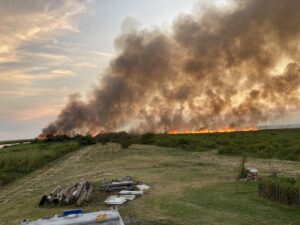
Sometimes, when he’s at home, Allaire hears the sound of equipment alarms going off at Calcasieu Pass. Last spring, he said he attended a meeting with a high-ranking Venture Global official. Allaire asked if the alarms meant he should shelter in place. The official, who did not respond to a request for comment from The New Lede, told Allaire to call 911 if he thinks he is in danger, he said.
Now when he hears the unsettling sound, Allaire watches and waits. “I just keep an eye on it and get ready to move if I see anything bad starting to develop over there,” he said.
According to a Federal Energy Regulatory Commission (FERC) resource for landowners affected by natural gas facilities, compressor stations have gas and fire detection systems and emergency shutdown equipment “designed to ensure that in the event of an accident, the compressor station would be safely shut down with minimal risk to the public.”
Venture Global and Sempra Energy did not respond to The New Lede’s requests for comment about concerns related to their LNG facilities.
A sinking seafood industry
The Louisiana seafood industry accounts for one in every 70 jobs in the state, with shrimp bringing in $1.3 billion and crabs bringing in $293 million.
Companies are often owned by families that have lived in the region for generations, many of which are the Cajun descendants of exiles who fled French colonies in what is now Canada following the French and Indian War, according to Lori Cooke, a program coordinator for the Louisiana Bucket Brigade and a fifth-generation resident.
Just 25 years ago, the fishing industry in southwest Louisiana was thriving, and the “biggest seafood provider anywhere in the world,” she said.
But today, the industry is in trouble.
“The LNG plants aren’t the only problem,” said Cooke. Warming waters and seafood imports that drive down prices also threaten the fishermen. “But the LNG plants and tankers and the facilities are really making it next to impossible for them to do their job. The only guidance they have is ‘stop being a fisherman.’ That’s what a lot of them have done.”
“If even one more of those [LNG terminals] goes through… I honestly don’t see how the fishing industry is going to survive at all,” she said.
One local longline fisherman who has been catching red snapper and other species since the 1970s told Cooke there used to be 100 fishermen like him that went out on the water every day, she said. Now, the number has dwindled to 12 or 15. That fisherman, she said, now works construction jobs to supplement his income.
“Nobody celebrates an LNG paradise,” said Cooke, noting that fishing and other traditions are what form southwest Louisiana’s identity. “There is no LNG festival.”
At least four or five days a week, LNG tankers more massive than cruise ships make their way up and down the Calcasieu Ship Channel, said Cooke, which connects Lake Charles to much larger Calcasieu Lake and, ultimately, the Gulf of Mexico.
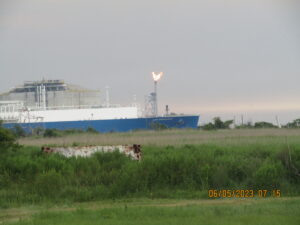
For crabbers like Berwick, the tanker traffic, which is set to increase as more LNG terminals are built, poses a major disruption. When the ships pass by, they create giant wakes that suck crab traps out into deeper water where they cannot be retrieved. This happens all the time, said Berwick, who recently gave up crabbing in the shipping channel.
“All last winter from November to April of this year, I was crabbing along the ship channel,” he said. “I got tired of losing traps. I probably lost 50 in a four- or five- month time.” With the traps valued at $50 apiece, Berwick estimates he lost $2,500 to $3,000 in gear during that brief period.
Dredging to widen the shipping channel for the LNG tankers has “pretty much changed the landscape from what it was in its natural form,” added Berwick. While Cameron LNG says mud from the dredging has been used to create 500 acres of marsh and wetlands, local shrimpers have complained that the activity prevents them from trawling. LNG projects could destroy 1,848 acres of wetlands, according to an analysis of FERC data by the watchdog group Oil and Gas Watch.
LNG tankers could also threaten fishermen’s lives. Pilots who guide the boats through the shipping channel have warned the fishermen to stay at least two miles away from the tankers, said Cooke. If they can see the LNG ships, they are already too close.
“It’s a lot of gas on the boats,” said Berwick. “If something were to happen and one of them were to blow up, I don’t think anybody in Cameron Parish would be safe.”
“For the sake of money”
When the Gulf region’s infamous hurricanes make landfall, they threaten everything in their path, including LNG infrastructure. Some terminals have already experienced damage from recent storms. After Hurricane Laura touched down in 2020, Cameron LNG vented 217 tons of harmful gases into the air due to a damaged pressure release valve. according to the Louisiana Bucket Brigade report. In 2021, strong gusts of wind were enough to trip the facility’s thermal oxidizer, resulting in the release of 87,335 lbs of methane, 1,334 lbs of VOCs, and 136 lbs of benzene.
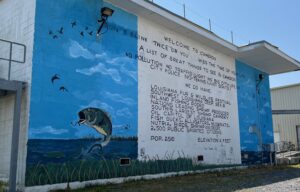
But Cooke suspects that LNG companies have benefited from past storms, too. Just as the community was regaining a sense of normalcy after the 2005 devastation of Hurricane Katrina, it was hit by Hurricane Laura in 2020, one of the deadliest storms to make landfall in the state, followed by Hurricane Delta a few weeks later.
“The LNG plants really took advantage of that,” said Cooke. “All of these permits were being accepted and things like public comment – nobody was paying attention because we were all distracted by hurricane recovery. It seemed like all of a sudden all these things started popping up and nobody knew what was going on.”
Venture Global’s says that company held three public hearings for the Calcasieu Pass project between 2014 and 2018. “During each event, hundreds of people from the community attended the open houses to learn more about the project,” the company’s website says.
Louisiana senator Bill Cassidy wrote a letter in 2015 to the chairman of FERC expressing strong support for the Calcasieu Pass project and its related pipeline. “The last decade has created unprecedented opportunities for business growth and job creation throughout the US,” he wrote. “Nowhere is this more evident than in Louisiana and along the Gulf Coast.”
“This is where we live, this is where we grew up, this is all we know,” Berwick said. “Our families have lived here for years and years, generations, and [the LNG companies] just come in here all for the sake of money and destroy our community. I’m not saying they’re going to push us out, but it’s definitely not going to be somewhere where you’re going to want to raise your kids.”
(Featured Image: The Calcasieu Pass LNG facility in Cameron Parish, viewed from a fishing boat on the Calcasieu Ship Channel. Photo by Lori Cooke, Louisiana Bucket Brigade)
